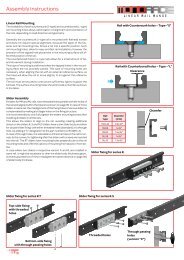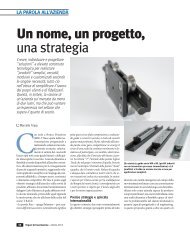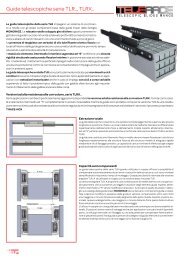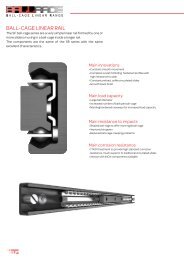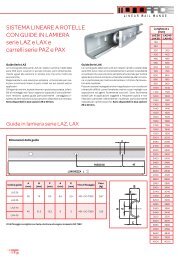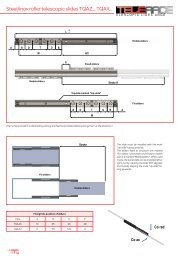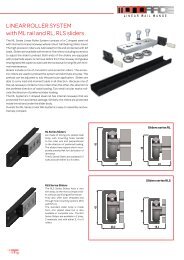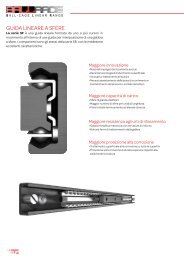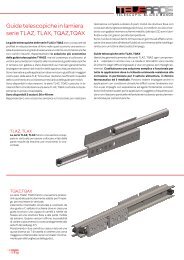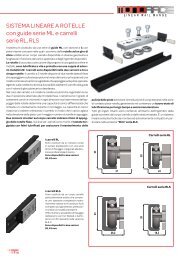general catalogue - T RACE SpA
general catalogue - T RACE SpA
general catalogue - T RACE SpA
Create successful ePaper yourself
Turn your PDF publications into a flip-book with our unique Google optimized e-Paper software.
FXR rails<br />
The rail is made from special carbon steel alloy to assure a good nitride hardening with our T <strong>RACE</strong>-NOX<br />
treatment. An innovative hardening technology applied to the linear rail products able to increase the<br />
hardness on the surface and in depth, enough to guarantee to support the typical Hertz’s stress in the point of<br />
contacts with the rollers, and to grant a strong resistance against corrosion, reducing the friction and the wear,<br />
for a long life of the rail.<br />
After nitride hardening the rails are processed with an oxidation treatment and subsequently a hot-oil<br />
impregnation to assure a nice black color and a high corrosion resistance. Now is also available the version<br />
FXR-P80 with holes pitches 80 mm, reccomended for high load application.<br />
+2<br />
- 4<br />
L (mm)<br />
400 560 720 880 1040 1200 1360 1520 1680 1840 2000 2160<br />
2320 2480 2640 2800 2960 3120 3280 3440 3600 3760 3920<br />
Weight (kg/m)<br />
2,09<br />
Roller positioning<br />
Co rad<br />
Co ax<br />
The roller must be correctly positioned with regards to load<br />
direction and also with sufficient number of rollers to assure<br />
requested load capacity and life-time.<br />
The load capacities are listed on page 23. Generally it is always<br />
preferable to position the rollers so the main loads are acting<br />
radially on the rollers, as highest load capacity for the rollers,<br />
i.e. Co rad. Load capacity is higher than axial load capacity Co<br />
ax, as the axial load is only acting on one raceway, compared to<br />
two raceways for radial loads.<br />
The rollers must be fixed to complete rigid and plan steel support<br />
and fixed with the below indicated tigthning torques for<br />
each type of rollers.<br />
While fixing screw of the rollers is maintained blocked with the<br />
key on the rear-end, each type of rollers has its own key/tool.<br />
When use of eccentric rollers, it is suggested to use a springwasher,<br />
between screw and roller, to facilitate the preload<br />
regulation before final tightening of roller.<br />
The preloading of the eccentric rollers are done, like explained<br />
for the sliders on page 32.<br />
Standard<br />
Allenkey<br />
Roller type<br />
Roller key<br />
Screw<br />
type<br />
Tightening torgue<br />
(Nm)<br />
R..18 Allenkey 3 M4 3<br />
R..28 Allenkey 4 M5 7<br />
R..43 Allenkey 6 M8 23<br />
R..63 KMR63 M10 38<br />
L..28 KLM28 M5 7<br />
L..43 KLM43 M8 23<br />
P..26 Allenkey 3 M5 7<br />
P..40 Allenkey 5 M6 11<br />
Lubrication of rails and rollers<br />
The correct lubrication of rails and rollers is very important to assure long life of the products, in<br />
case of high frequency applications. In such cases it is suggested to clean raceways and rollers<br />
and re-lubricate every approx. 100.000 cycles, in normal operation conditions.<br />
We suggest to use grease for high precision of type “Classe NLGI2 (ISO2137) .<br />
Special flatkey<br />
KM. KL.<br />
27



